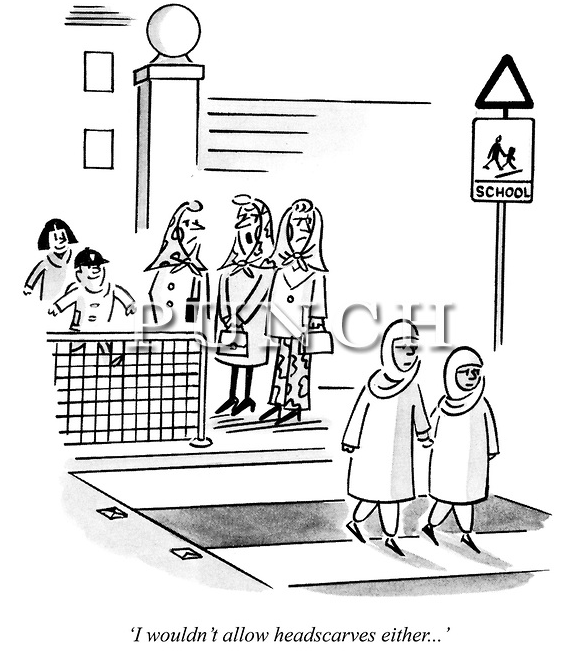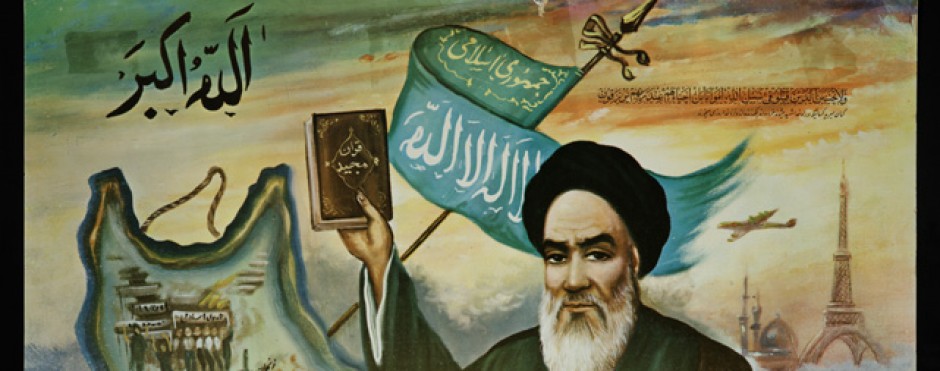The media-driven view of Islam in the Western world is full of stereotypes, false information, and misunderstandings of the religion and what its practitioners believe. One of the most prevalent views is that all Muslim women are oppressed, and the veil is often the symbol of this oppression. While it is true that in early literature on Islam, women’s voices were missing and underrepresented, they were not as invisible as is depicted. There have been major movements lead by Muslim women for women, and when compared to women’s struggles for rights in the United States, their struggle becomes more familiar and less foreign.

This cartoon demonstrates the critical and negative view Western media takes on Islam, specifically on Muslim women, yet how Western women have followed a similar path.
![]()
Looking first at writings on Islam historically, a great example is to look at India. Every source read in our class was written by a man with little to no mention of women in their works. Two of the loudest voices were W.W. Hunter and Sir Syed Ahmed Khan, writing from a Western and Indian perspective respectively, on the debate of whether or not Islam can modernize with the West. A huge missing piece in their works was the place of Muslim women in the modernization of Islam. This is an important piece because around the same time they were writing, the first wave feminism was starting and becoming a huge deal in the Western world, the United States specifically. But Western women were not the only ones gaining voice.
During the time Hunter and Khan were writing, women were still living under purdah in India. Purdah is an Indian tradition that keeps women out of the public sphere and in the home allowing men to run the rest. Although it was a tradition all Indian women were held to, Muslim women were held to these laws as well as additional Muslim laws that made their lives stricter than other women’s. It limited their ability to go outside the home and speak to people outside their homes and family. In the early twentieth century women began organizing and fighting for more rights, and in the 1910’s Indian women won the ability to follow purdah only as much as their religion determines they should. While this was a success for many women, Muslim women still drew the short straw here since their rules were still the strictest (Saiyid, p 79). However they still moved forward, and in the same decade the first Muslim women was elected into the Indian Women’s Association. Previously non-Muslim women held all fourteen elected positions in this organization. As Muslim women gained more seats and more space, they were able to gain more of a voice in their community (Saiyid, p 88).
Looking ahead to the 1980’s, another wave of Muslim women in Turkey were gaining their voice and asking for the their rights and religious choice. This movement was different in comparison with the women earlier in the century in India. The Indian Muslim women were looking to leave behind some traditions, while the women in Turkey were asking for the right to more openly practice their religion. The debate about headscarves has not stopped since then. Women in Turkey in the 80’s were fighting to be able to wear their headscarf in public because the government banned the headscarf as it moved to be more secular (Sandikci and Ger p 21). The movement was organized and driven by women working for their own rights and the ability to choose how they wanted to express their religion. One of their arguments for wearing the scarf was that wearing it allowed them not to be viewed sexually by men, and this allowed them to have better friendships with men since there was a clear line. Some women said that it was harder to be friends with men without the veil because it was hard to know each other’s intentions (Sandikci and Ger p 23). Just like the India Muslim women who were trying to loosen the rules their religion put on them so they could more freely and comfortably move and work around their world, Muslim women in Turkey were trying to gain the rights to more religious practices in order to achieve the same personal and social comfort.
So what is it that makes these two movements so important? Looking at them from an American point of view, it is important to look at these movements in context with our own history. Both these movements happen at almost the same time as major waves of feminism here in the United States. While Indian Muslim women were fighting back the oppression of purdah in India, American women were working towards the right to vote here in the first wave of feminism. Women in Turkey were organizing and fighting for the right to wear the headscarf only a few years after the height of second wave feminism. It is important to remember the global context of these events. Women in the United States were fighting for their own rights at the same time as Muslim women were in other parts of the world.
In a similar struggle to that of American women, Muslim women have been working and fighting hard for their own rights and towards equal footing with men. Although their struggle is far from over, we can still see similar inequalities in the Western world in different contexts. This shows us how the oppression Muslim women are under and difficulties they face are not just from their religion, but from a global society at large that women around the world suffer from, and Islam is not to blame. Looking at these and other movements in a broader, more global context, reminds us that we are all fighting for the same equality.
References:
Ayla Göl (2009) The Identity of Turkey: Muslim and secular, Third World Quarterly, 30:4, 795-811
COLIN BLAKEMORE and SHELIA JENNETT. “purdah.” The Oxford Companion to the Body. 2001. Encyclopedia.com. 3 Nov. 2015 .
Saiyid, Dushka. Muslim Women of the British Punjab: From Seclusion to Politics. New York: St Martin’s Press, Inc., 1998. Print.
Sandikci, Özlem and Ger, Güliz. “Veiling in Style: How Does a Stigmatized Practice Become Fashionable?” Oxford University Press: Journal of Consumer Research, Vol. 37, No.1 (June 2010), pp 15-36
Syed Ahmed Khan, Review of Dr Hunter’s Indian Musalmans (London: 1872). Available in full: https://archive.org/details/reviewondrhunter00ahmauoft
W. W. Hunter, Indian Musalmans: Are they bound in conscience to rebel against the Queen? 2nd ed., (London: 1871 [1872]). Available in full: https://archive.org/details/indianmusalmans02huntgoog
